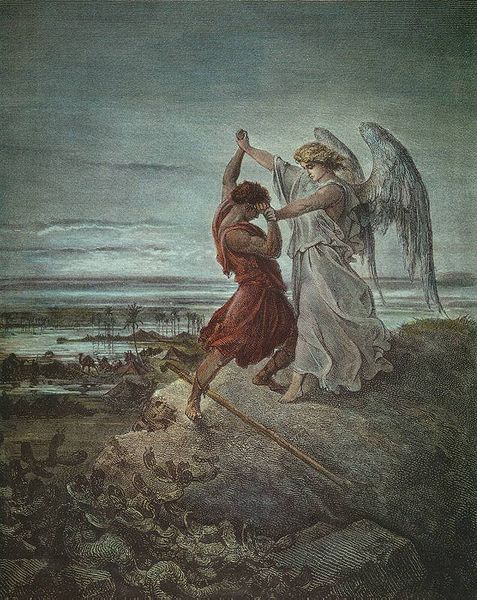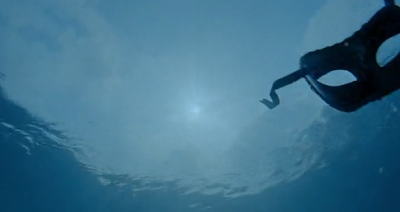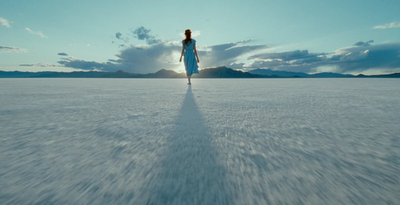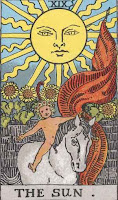Terrence Malick's The Tree of Life swims in familiar archetypal waters. It's Sophia and Yaldabaoth, Love and Wrath, Grace and Nature, Lily and Snape. The film begins with a quote from the book of Job. Jack (Sean Penn), like Job, has to learn to understand his Father's actions. The Mother and the Father are battling it out inside of his psyche; his mind is the scene of the crime. We are told at the start of the film that Jack's brother R.L., who would balance the two pillars, is dead; it is the realization of this loss that is the impetus for his quest--the Mother and the Son, like Goethe's ewige Weiblichkeit, call him home. "Brother--Mother--It was they who led me to your door." This is juxtaposed with the creation of the universe--the consciousness of separation was an inevitable result of the Lightning Flash. The archetypal drama of the macrocosm is played out in the microcosm--quod est superius est sicut quod est inferius.
Each shot or scene is a piece of the puzzle, and the pieces sometimes cohere into distinct patterns or panoramas that you can look and say, “Oh, of course, this is the creation of the universe, which ties into the creation of Jack’s own personality” or “this part is about the love-hate relationship between Jack’s mother and father and the traumatic effect that their conflicts had on the children,” or “this part is a freestanding sketch of the dad’s personality that gives us insight into who he is.” (Salon.com)
Jack is an architect, i.e., a Demiurge (Harry "Potter"). The creation of the universe is the creation of Self. The Tree of Life is Malick's Great Work. We are seduced by Mrs. O'Brien (Jessica Chastain), the Sophia-archetype; but she, too, is Malick's alchemical creation. And obviously Mr. O'Brien (Brad Pitt) is Tyler Durden, the Demiurgic Father God-archetype who just wants his children to be strong enough to overthrow him. (But is this not also Malick himself? Note his obsessive perfectionism and piety.) Mr. O'Brien tells Jack to shut the door "50 times"--surely a reference to the 50 Gates of Understanding through which the Kabbalist must pass when navigating the Tree of Life.
"Father, mother, always you wrestle inside me, always you will."
The Tree of Life is a very Christian, indeed very Catholic, film. Pitt is the Father God, the cliché of the Old Testament judge. He is religious, and more complex than I am suggesting here. But ultimately it is Chastain’s character who is redemptive, and who in the film’s final sequence surrenders one of her three sons in an act of unspeakable grace. She, not the macho sky-god of the oxymoronic “Religious Right,” represents religion as Ought; as the impulse toward poetry rather than the prosaic. Of course, in the chauvinism of traditional religion, it is the feminine that is denigrated as too earthly, too fleshly. Yet here the feminine, precisely by refusing to denigrate the earth, also embodies its transcendence. (Religion Dispatches)
"My girl Holly and I have decided to kill ourselves, same way I did her Dad. Big decision, huh?"
In The Tree of Life the spectator is young Jack, the diminutive of Jacob [sic], the man who fought with God . . . . Didn’t you immediately identify with him? Not just for poetics the baby comes out from his uterine house to Waco. He was already born. . . . He knew he would fall in love with his creation. And, more important, he knew he trusted him (“Do you trust in God?”, asks the priest during the sermon; “I trust you”, says RL to Jack). He was perfect for him to commit his crime. “He was in God’s, hands the whole time”. . . . (Reviewing Tree of Life)
Jung goes on in Job to say that the image of God also lacks the feminine dimension–traditionally viewed as relatedness, Eros, or anima in Jungian analytic terms but, as Jung crucially explicates, also represented in the Christian deity archetype by Sophia, or wisdom. Accordingly, after confronting God’s mean-spiritedness and despotism in the Book of Job, Jung next considers “Lady Wisdom,” who makes a biblical appearance in Proverbs. For Jung, she is the “prototype” for the human Virgin Mary (later deified) of the New Testament, who helps incarnate God’s later, more evolved incarnation of Himself in the human form of his son, Jesus. The crowning moment of this feminine-aided incarnation, so to speak, is Christ on the cross, because “at that moment God experiences what it means to be a mortal man and drinks to the dregs what he made his faithful servant Job suffer. Here is given the answer to Job” (para. 647). Jung continues this idea a bit later, stepping back for a wider perspective, “Yahweh’s intention to become man, which resulted from his collision with Job, is fulfilled in Christ’s life and suffering” (para. 648). God is moving, in this view, out of his unconsciousness and primary narcissism and becomes a “God in time.” The “answer,” then, is when God as Christ crucified becomes fully human and can now empathically see and suffer humanity’s pain. (David Sedgwick)
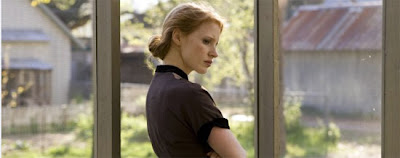
In my neighbor’s yard there grows a tree
It stands alone in an ocean of green
Like a siren of the sea, she beckons me,
“Forbidden fruit is the sweetest, you’ll see.”
Tempting visions swirl in my head
Of juicy fruit in tangerine red
Deep in my heart it planted a seed
I yearn for the fruit on my neighbor’s tree.
Within my soul the seed took root
I dreamed in green and of sunkissed fruit
My will being weak, I could not withstand
So surely and coldly, I formed my plan.
I stole into his yard last night
And killed my neighbor in a deadly fight
In wicked eagerness I savored my treat
I always knew forbidden would taste sweet. (Terrence Malick?)
 |
| Just a garden hose? (Mrs. O'Brien nourishes the sons with the waters of the serpent.) |
 |
| 'Why do you think Steve is filmed like a snake in bed (a glorious shot, just astonishing) when mother reads the boys Kipling?: “and they went off to look for Kaa, the Rock Python. They found him stretched out on a warm ledge in the afternoon sun, admiring his beautiful new coat.”' (Reviewing Tree of Life) |
The Tree of Life is full of serpent symbolism (which is, I suppose, right where it should be). But Malick is evidently a Gnostic and gives the serpent to his Sophia, who initiates the children when Father is away (he told them not to cross over into the neighbor's yard, where the Forbidden Fruit of the Tree of Knowledge dwells--but their Garden yard is dying).
Shame intrudes on the Garden State of childhood when he traverses the line drawn by the Father and enters the neighbor's house. This is an initiation into sexuality; the felix culpa that will also be the force of his regeneration.
Jack pursues the New World, but she is removed from him. In the present day, Jack is the impotent king (Juno again), his wife is cold and barren. Yet a light has now been rekindled.
 |
| The Mask |
And when Jack gets reconcieled with his father? Some abstract “they” is closing the plant: the film/game must end (didn’t you noticed that in the late ’60s they live in a much bigger house with a pool, more sophisticated, with tribal art?: “They never talk about their money.”). He must leave his “heterotopia”. Speaks to his son about how tough he was with him and how he doens’t get proud of it: he just wanted to make him is own boss. . . . When the architect gets out of the skyscrapers he is for the first time in black tie in the “real world”. He finally “killed himself”, was re-borne and can now admire his creation, in the form of the mirrored skyscrapers. Can finally call himself Jacob/Jack with no problem: “I have seen God face to face and lived”. (Reviewing Tree of Life)
“Some day…we’ll understand it all, all things” declares the pious Pitt, even as he inwardly seethes over his failures and his perceived lack of appreciation. And so a release from the chains of cause and effect must feel transcendent; and yet, must be human choice. Penn’s adult forgiveness is one of the few uniquely human acts in the film, an act not linkable to animal behavior (contrast it with another such act, shooting animals for pleasure as a child). When Chastain then whispers “I give him to you” to Penn’s wife, we have an inkling of what possibilities have been unlocked. By forgiving his father Penn is potentially allowing himself to be more open, to drop the stiff mask of cultural and personal history that all characters in the movie wear, to perhaps mend the icy formality that exists between himself and his wife. (Linguafantastika)
 |
| The Son emerges from the depths of the waters |
At the end of the film, Malick discards any pretensions of literalism, and we watch as he destroys the universe. Jack the Prodigal Son steps through the stargate and now reconciles himself with the Father--the Mother (Isis) gives him the Third Son, the mediator (Tiphareth--Kubrick's Star Child, Horus) when he removes his Mask. (We should not be surprised at an homage to Kubrick's 2001; Douglas Trumbull worked on both films.)
Terrence Malick’s vision is much more wholistic than the simplistic “Nature versus Grace” paradigm suggests. The conclusion of “The Tree of Life” offers a vision of the unity of all things. At the end of the film Mr. and Mrs. O’Brien meet in, what seems to me to be a vision of the unity of all things. It is a vision that takes place inside Jack’s adult consciousness. It is here that the O’Brien parents exchange their only real embrace and their only true kiss.
Finally, Malick suggests, Grace and Nature must kiss. They must be united. We need both the force and the form of Nature, as well as the freedom and the spontaneity of Grace. (Christopher Page)
Having started with the Big Bang of Genesis, Malick concludes with a vision from Revelation 22 where the angel showed John, “The river of the water of life, as clear as crystal, flowing from the throne of God and of the Lamb, down the middle of the great street of the city. On each side of the river stood the tree of life.” Malick skips the city, but concludes with the eponymous tree. The tree incident from Genesis is widely recounted. But how rarely we talk about the tree of life in Revelation whose magic leaves include healing for the nations. The tragic beginning of the biblical story comes full circle into a radiant, fruitful finale. Malick restores the full tale of the tree.
All the characters reunite in a state of bliss, a dramatic curtain call. Pain and sorrow seem to have vanished. Dad holds his son aloft. Angels attend to Mother. As the sounds of Berlioz’s “Agnus Dei” rise, she lifts up her considerable burden. This moving requiem celebrates “the lamb of God who takes away the sins of the Lord.” Mrs. O’Brien releases her son to God and a field of sunflowers appears. (Purple State of Mind)
It is quite evident that this is a visual depiction of something that appears in Jung's Answer to Job: Sophia aids the incarnation of the Christ who will reconcile opposites in Himself. This divine Son is named, appropriately, R.L., the River of Life, the Elixir of Immortality flowing from the Tree of Life. "I know that my Redeemer liveth . . ."
Jung's Answer to Job – at least what I can make out from it – examines the Book of Job as something that forced God to confront His own reflection, which would consequently result in His change of heart and attitude of forgiveness and selflessness, manifested in Jesus, who Himself, to be theologically correct, crosses between pairs of opposites and binaries, not being Half-Man and Half-God, but is All-Man and All-God, a contradiction that accepts, like Whitman, that it contradicts itself in its multitudes: "I and this mystery, here we stand." For Jack, the mercy of his suicidal brother (who chooses not to take the option of revenge on Jack, even after Jack had betrayed R.L.'s trust and shot his finger – such an important tool for him – with a bee-bee gun) and grace of his mother, are the two things, so we learn in the film's opening whispers, that brought the subject (in this case, Jack) "to Your door." "Find me," Jack's younger self whispers to the older Jack, standing on the shores. We see his shadow, his 12-year-old gaze on his own feet walking. "Forgot You…How did I lose You?" Is he talking about God? The Eternal sense of Being? His brother? His younger Self? Most likely, he is referring to all of those things. Would Jack be wrestling with his sense of Being-ness had his brother not died? Is the glory born of a felix culpa, a Happy Fall? The grisly bondage of the crucifixion opens the way to the Resurrection, and once more there is symmetry between R.L. and Christ, joy and suffering. (The Niles Files)



